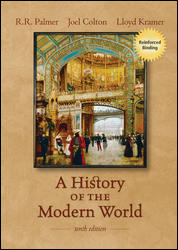
History of the Modern World, 10th Edition (Palmer)Chapter 13: True Global Consolidation of Large Nation-States, 1859-1871Chapter OverviewFrom the 1860s and 1870s onward, the nation-state became the primary model of social, political, and economic organization in Europe. The large nation-states were consolidated through a two-fold process. Territorial integration was followed by a moral and psychological unification that often involved the expansion of liberal and representative institutions. The Crimean War, which weakened Austria and Russia, set the stage for the success of various European nationalist movements. Italy was unified through the efforts of Piedmont’s prime minister Cavour and the republican Garibaldi and his followers, the Red Shirts. Bismarck’s pragmatic use of power brought the North German Confederation into existence, which was then subsumed by a new German Empire dominated by Prussia. In Austria and Hungary, a bargain struck between Germans and Magyars brought unity at the expense of other nationalities. Imperial Russia underwent westernizing and liberal reforms during Alexander II’s rule, sharing in the European-wide trend toward liberalism. In the United States and Canada, secessionist and separatist tendencies, not unlike the nationalism of many European peoples, were checked by war and new policies of government. Finally, Japan emerged from several centuries of isolation, and transformed itself into a modern nation more unified than many western countries but without relinquishing its own culture. |  |















